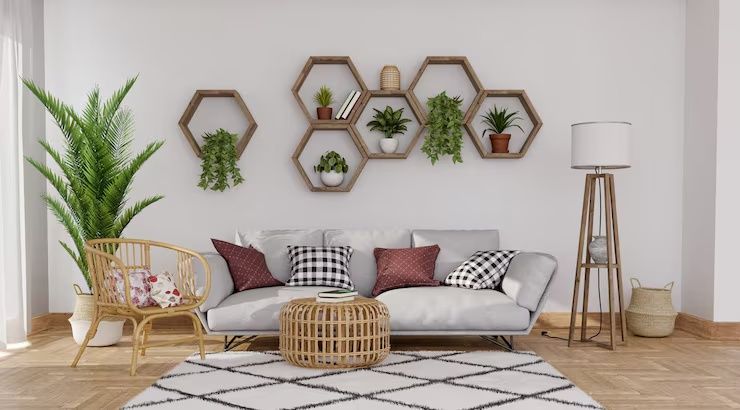Home decor encompasses the art and science of enhancing the interior of a house to create a more aesthetically pleasing and functional environment. It includes the selection of furniture, color schemes, lighting, textiles, art, and accessories to reflect personal style while optimizing comfort and usability.
Importance
Home decor is significant for multiple reasons:

-
Enhances comfort: Proper arrangement and selection of furnishings improve everyday living experiences.
-
Supports mental well-being: Thoughtful spaces can reduce stress, promote relaxation, and encourage creativity.
-
Reflects personal style: A well-decorated home communicates individual tastes and lifestyle choices.
-
Increases functionality: Smart design solutions optimize space, storage, and workflow in homes.
-
Impacts property value: Good interior design can enhance resale potential.
The influence of home decor extends beyond aesthetics, affecting health, lifestyle, and economic considerations.
Recent Updates
In 2023–2024, the home decor industry has seen notable trends and innovations:
-
Sustainable materials: Growing use of eco-friendly furniture, recycled textiles, and low-impact paints.
-
Smart home integration: Lighting, climate control, and home automation systems are being incorporated into design.
-
Minimalist and multifunctional design: Smaller homes are using multifunctional furniture and decluttered spaces.
-
Biophilic design: Incorporating plants, natural light, and organic materials to connect indoor spaces with nature.
-
Color trends: In 2024, earthy tones, soft pastels, and jewel hues are dominating interior palettes.
-
Digital visualization: VR and AR apps allow homeowners to preview layouts and décor items before implementation.
These updates reflect a combination of aesthetic preference, sustainability, and technological integration.
Laws or Policies
Home decor is indirectly affected by regulations and programs that influence materials, construction, and safety:
-
Building codes: Ensure structural integrity and safe installation of fixtures, lighting, and furniture.
-
Fire safety regulations: Flame-retardant materials and emergency planning guidelines must be followed.
-
Environmental standards: Policies encourage low-VOC paints, sustainable sourcing, and energy-efficient lighting.
-
Housing policies: Government incentives for energy-efficient renovations or smart home installations may impact decor choices.
-
Consumer protection laws: Guarantee product safety and accurate labeling of furniture and materials.
Compliance with these rules ensures safe, eco-friendly, and legally compliant home interiors.
Tools and Resources
A variety of tools and resources can assist in planning and executing home decor projects effectively:
-
Design apps and software: Tools like SketchUp, HomeByMe, and Planner 5D help visualize layouts.
-
Color palette generators: Digital tools assist in matching colors for walls, furniture, and decor items.
-
Furniture and décor databases: Online catalogs and supplier websites provide specifications and inspiration.
-
Mood board platforms: Pinterest and Canva allow curation of design concepts.
-
Virtual reality (VR) and augmented reality (AR): Visualize decor choices in real-life spaces.
-
Interior design blogs and guides: Provide expert insights, DIY tips, and trend analysis.
Example Table: Popular Home Decor Styles
| Style | Key Features | Ideal For |
|---|---|---|
| Minimalist | Clean lines, neutral colors, clutter-free spaces | Small apartments, modern homes |
| Bohemian | Layered textiles, eclectic patterns, rich textures | Creative, personalized interiors |
| Scandinavian | Functional, cozy, light colors, natural materials | Warm, airy spaces with minimalist design |
| Industrial | Raw materials, exposed brick, metal accents | Urban lofts, contemporary designs |
| Contemporary | Sleek furniture, neutral palette, bold accents | Modern family homes |
This table highlights diverse home decor styles and their defining characteristics.
FAQs
What is home decor?
Home decor is the practice of designing and arranging interior spaces to enhance aesthetics, functionality, and comfort.
How do I choose a decor style?
Consider personal preferences, space size, lifestyle needs, and current trends to select a style that suits your home.
Can home decor improve mental well-being?
Yes, thoughtfully designed spaces with proper lighting, color, and organization can reduce stress and boost productivity.
What are sustainable home decor practices?
Using eco-friendly materials, low-VOC paints, energy-efficient lighting, and recycled furniture supports sustainable living.
How can technology assist in home decor?
VR and AR apps, digital planners, and online visualization tools allow homeowners to preview layouts, furniture, and color schemes before implementation.
Conclusion
Home decor is an essential aspect of creating functional, comfortable, and aesthetically pleasing living spaces. It influences personal well-being, lifestyle, and property value while reflecting individual taste.
Recent trends in sustainability, smart home technology, biophilic design, and digital visualization have transformed how homeowners approach interior design. Understanding safety regulations, environmental standards, and available tools ensures successful planning and execution of home decor projects.
By combining creativity, practical solutions, and modern tools, individuals can enhance their living spaces in ways that are visually appealing, comfortable, and aligned with contemporary lifestyle demands.